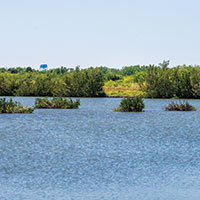 Designer defends effectiveness of Spoonbill Marsh
Designer defends effectiveness of Spoonbill Marsh
STORY BY KATHLEEN SLOAN
The designer of the county’s Spoonbill Marsh recently defended the county’s water purification facility against charges by environmental activists that it is hurting – not helping – the lagoon, and contended that the project is in fact a “great success.”
The activists cite high nitrogen numbers, disappearance of salt marsh habitat taken over by mangroves, and flooding of property next door owned by the Indian River Land Trust as evidence that Spoonbill Marsh may actually be harming the environment.
But Chip Swindell, owner and head engineer of Ecotech Consultants, which was hired by the county to design the project a dozen years ago, said he has successfully designed 35 facilities similar to Spoonbill that use the natural filtration of plants and soil along fresh- and salt-waterbodies to clean pollutants.
“I want there to be more of these multipurpose facilities – to preserve and promote wildlife and natural habitat and to treat waste water – and there are fewer and fewer opportunities to do so in Indian River County,” Swindell said, waving a list of wildlife species he said he has identified on the 69-acre site. “Spoonbill Marsh has been a great success.”
Swindell said he chose the site, just north of Grand Harbor, which owns the land and gave the county a utility easement over the acreage, in part because the land would cost taxpayers nothing and also because of the red mangroves already on the marsh. He had just completed a similar facility in Australia, exploiting the aerial root system of the red mangroves which he said makes it an excellent filter.
Spoonbill Marsh was approved by the Florida Department of Environmental Protection in 2008 because it promised several benefits. First, it would treat about 2 million gallons a day of mineral-heavy concentrate, the side stream from well water treated via reverse-osmosis at the county’s north treatment plant to make it potable.
Second, it would remove nutrients from the lagoon. About 4 million gallons a day of lagoon water is mixed with the 2 million gallons a day of concentrate. The blended 6 million gallons a day is pumped first to settling ponds and then through a spaghetti-like network of runnels, eventually converging at two major outfalls into the lagoon.
As a final benefit, the project preserved 69 acres of waterside terrain for wildlife, sparing it from development.
Despite Swindell’s rosy portrayal, Indian River County residents Barry Shapiro and Carter Taylor have successfully petitioned the Florida Department of Environmental Protection to delay the county’s permit renewal application until questions about high nitrogen levels and inconsistencies in reported data can be explained.
The state permit, which is needed to operate the facility, ran out in September 2017. County Utilities Director Vincent Burke said the permit has been “administratively extended,” while reporting inconsistencies are checked out.
Nitrogen is the chief pollutant in the Indian River Lagoon. A nutrient that enters the lagoon via leaking septic systems and fertilizer-laden runoff from farms and lawns, it feeds algae blooms that destroy plant and animal life by using up oxygen and blocking sunlight needed for sea grass photosynthesis, the backbone of the lagoon ecosystem.
Monthly reports turned into the DEP by the county show that lagoon water going into the facility is loaded with nitrogen. For November 2017, the average for total nitrogen was 2.1 milligrams per liter.
The same reports show water flowing out of the facility with less than half that much nitrogen, .91 milligrams per liter. The contrasting numbers allow the county to claim credit for a major nitrogen reduction, something that helps meet requirements of the state permit.
But Shapiro and Taylor question the high input number, noting water samples taken by St. Johns River Water Management District that show total nitrogen is about .57 milligrams per liter in the middle of that stretch of the lagoon and .89 milligrams per liter near the shore.
They want to know why lagoon water pumped into Spoonbill is reported to have so much nitrogen, possibly inflating the facility’s nitrogen-removal claims. At the same time, they note, if the county’s figures are accurate, the marsh outflow carries nearly twice the level of nitrogen St. Johns found in its samples, meaning the marsh could actually be polluting the ecologically sensitive waterway.
Swindell said the St. Johns sample is from the middle of the lagoon, while Spoonbill’s is from the shoreline, which is consistently much higher. He also claims there is good and bad nitrogen – just like cholesterol – and looking at total nitrogen is insufficient for determining benefit.
Shapiro and Taylor have also demonstrated, through aerial photography, that the saltwater marsh intended to be the natural filtration system to remove nutrients has been largely taken over by white mangroves at the Spoonbill site. The same displacement has occurred on the Land Trust property to the north, which was purchased to preserve the rare salt marsh.
They also have photographs of the Land Trust property being flooded, and they have asked the Department of Environmental Protection to investigate whether Spoonbill’s pumped water is escaping its borders and flowing untreated into the lagoon, destroying salt marsh in the process.
The flooding is not due to Spoonbill Marsh overflow, but “to the tidal fluctuations in the river,” according to Swindell.
Swindell said he too is perturbed by the takeover of white mangroves, but denies it’s due to Spoonbill’s operations. “White mangroves are taking over areas up and down the lagoon, the high spring and fall tides bringing the seeds up, which germinate almost immediately. I asked the DEP if we could apply an herbicide to eradicate them and they said ‘no, they’re protected.’”
The Florida Department of Environmental Protection will give written answers to questions submitted by the public at the same time it issues a decision on the permit in late May.








